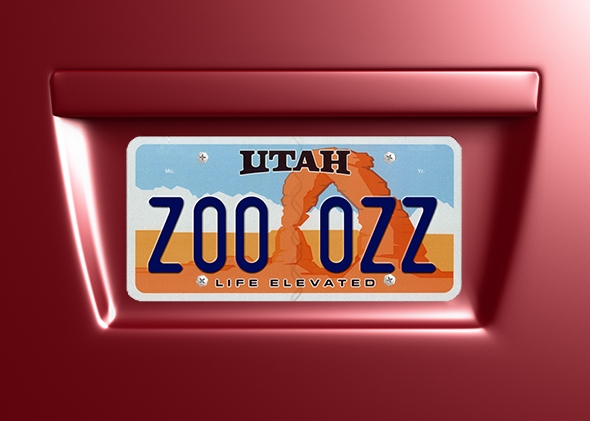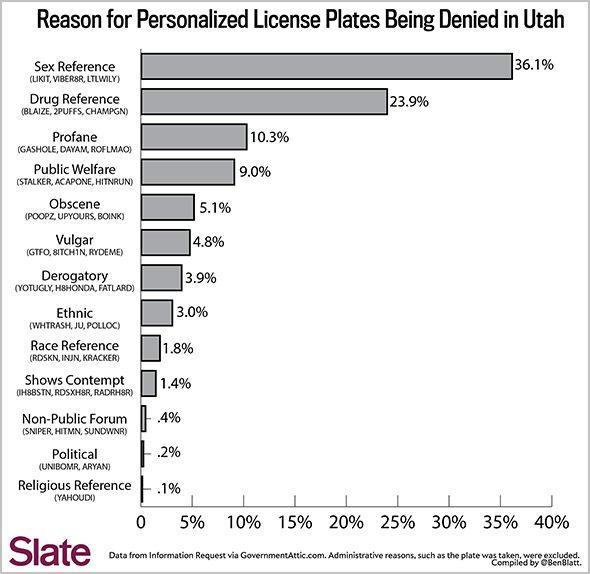D3N1ED PL8S
995 vanity plates that were too risqué for the Utah DMV.

Photo Illustration by Slate. Images Courtesy of Shutterstock and Utah DMV.
Use the arrows to view them.
In 2012 the website GovernmentAttic.org, citing open-records laws, requested that each U.S. state provide a list of the vanity license plates it has prohibited. Not all states were forthcoming. Wyoming sounded downright embarrassed. “I am not comfortable providing our list of prohibited personalized license plate combinations,” wrote a representative from the state’s department of transportation. “The list contains common 3 and 4 letter words or abbreviations that should not be spoken in mixed company.”
Utah, by contrast, complied with the request, sending along a list of nearly 1,000 plates that have been rejected over the years. Like many states, Utah reserves the right not to issue plates that its Division of Motor Vehicles deems inappropriate, either because the plate is obscene, offensive, or otherwise untoward.
Of course, obscenity is famously difficult to define, and some aspects of Utah’s personalized plate laws are easier to interpret than others. The state has issued a more-or-less blanket ban on the number 69, unless “used in a combination with the vehicle make, model, style.” This rule triggered the rejection of at least 39 license plate requests—including 69METS, a seemingly innocuous nod to the New York Mets’ first World Series championship in 1969. But most of the rules are a bit vaguer, leaving it to state officials to know an offensive plate when they see one. Often, the obscenity is plain as day, as in the cases of CARGASM, SKISLUT, and NAZI. Other applicants are cleverer, though not cleverer than the DMV’s watchdogs, who caught MLHICLB, FAHQUU and TIH2TA3 (read that last one backwards).
Most people whose risqué vanity plate applications are denied probably shrug and get on with their lives. But some drivers have fought back. In 2012 a citizen in North Dakota who had previously held the plate HONKY made an official appeal to the North Dakota Department of Transportation after being denied the plate when trying to reregister it. The appeal was successful on the grounds that it was in reference to honky-tonk music. A man in New Mexico argued, through his attorney, that his rejected plate IB6UB9 was not sexual innuendo but an inside joke, about gambling. “The phrase originated when Mr. Anaya was at a casino with an acquaintance playing roulette, and during the course of the roulette game the comment was made by Mr. Anaya to his acquaintance; ‘I be six, you be nine.’ ”
Like Utah, most states rely heavily on loose guidelines. Some, like Wisconsin, provide DMV employees a checklist of tricks to be on the lookout for (“1. Does the message contain FU?”; “7. Check for foreign words”). Michigan’s guidelines recommend that its guardians of public decency rely on a series of websites, including UrbanDictionary.com, to help them find alternate, unsavory meanings. New Mexico even checks the binary translation of plates with several 0’s and 1’s.
The sample of 995 plates denied by Utah for nonadministrative reasons—that is, not because they were too long, or already taken—was released in 2012, and it has some unknown qualities to it. For instance, the document doesn’t specify how far back the list of banned plates goes. Citing a computer system upgrade since the list was generated, a representative from the state told me it was not possible to determine the dates the document covers.
Utah’s rejected plates are sorted into a handful of categories that are meant to convey why the plate was denied. But several of the categories would seem to overlap. The state does not specify the differences between the Vulgar, Profane, Obscene, and Sex Reference categories, for example, and plates seem to be sorted into them in arbitrary fashion: BEAVER was marked as a Sex Reference while BEAVERS was marked as Obscene; WOODY was labeled Obscene while WOODIE, WOODSY, WOODY56, and WOODY63 were all marked as Sex Reference.
Though not ideal for analysis, the categories do provide a general sense of the kinds of mischief Utah drivers have tried (and failed) to get into:

Of course, these statistics only tell us how many plates of each type were actually caught; there is no way of knowing how many uncouth plates in each category were submitted. Only with complete license plate records (which are not public information) could we know how many plates with drug references slipped by the workers in the Utah state government. All we know for sure is that every standard Utah license plate bears the state’s unambiguous tourism slogan: “Life Elevated.”